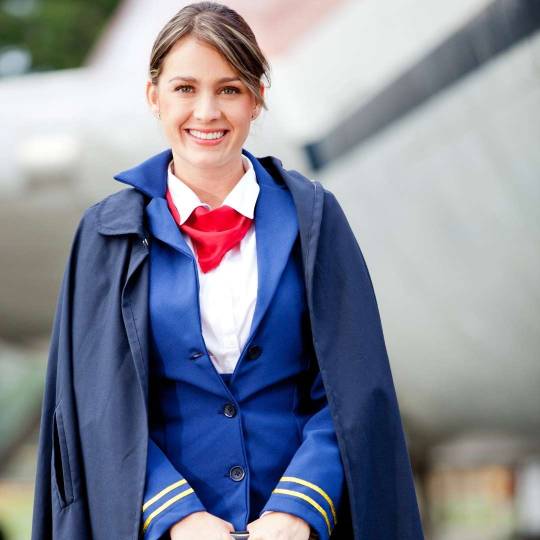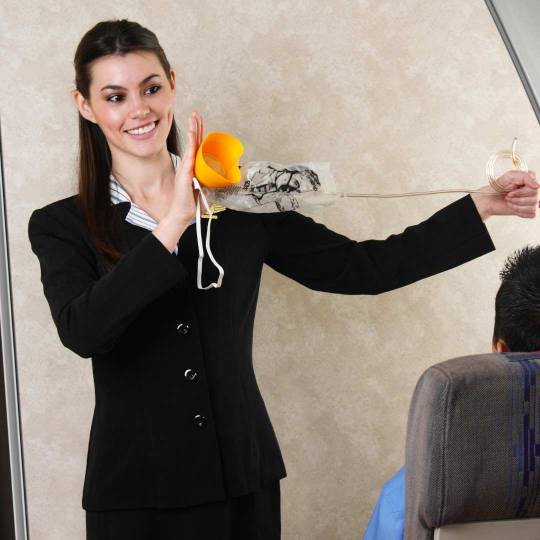#FlightAttendantProgram
Explore tagged Tumblr posts
Text
Choosing a Flight Attendant Program: A Guide to Starting Your Aviation Career

The role of a flight attendant is fast-paced, challenging, and highly rewarding for those who love to travel, meet people, and help others. If you're considering this career, enrolling in a flight attendant program can provide the skills and confidence you need to succeed. These programs teach more than just in-flight duties; they prepare you for the full range of responsibilities that flight attendants encounter on a daily basis. In this blog, we'll discuss the key aspects of flight attendant programs, from training components to career opportunities.
What Does a Flight Attendant Program Cover?

Flight attendant programs offer comprehensive training designed to meet the safety and service demands of the airline industry. Most programs blend classroom learning with hands-on practice, ensuring students gain the practical skills required to perform their duties with confidence. Here are some of the primary subjects covered:
Safety and Emergency Training: Safety is a top priority for airlines, and flight attendants play a critical role in ensuring passengers' well-being. Programs cover extensive emergency procedures, from handling decompression situations to using emergency exits, fire extinguishers, and life vests. Trainees practice evacuation drills, emergency landings, and in-flight safety demonstrations.
Customer Service Excellence: Flight attendants represent their airline and are key to delivering a positive travel experience. Training includes customer service skills, emphasizing communication, conflict resolution, and cultural sensitivity. Flight attendants learn how to handle various customer needs and navigate challenging situations, such as managing difficult passengers or helping those with special needs.
Medical Response and First Aid: As first responders on flights, flight attendants are trained to manage medical emergencies. Flight attendant programs teach basic first aid, CPR, and how to use Automated External Defibrillators (AEDs). This training prepares flight attendants to respond to health crises, such as heart attacks or severe allergic reactions, when immediate medical attention is crucial.
Airline Operations and Procedures: Trainees learn about the day-to-day operations of airlines, including ticketing, boarding, and deplaning procedures. This knowledge ensures flight attendants can coordinate with ground staff, pilots, and fellow crew members to provide a seamless and safe experience for passengers.
Cultural Awareness and Diversity Training: Flight attendants serve people from diverse backgrounds, so many programs emphasize cultural sensitivity and understanding. Trainees learn about the customs and expectations of passengers from different cultures, helping them deliver inclusive and respectful service. This training is vital in a global industry where understanding diversity can enhance customer satisfaction.
The Importance of Hands-On Simulations
One standout feature of flight attendant programs is hands-on simulation training. Programs often use replica cabins and other mock setups that mimic real flight conditions. Through these simulations, students practice their roles in a controlled, realistic environment. They run through emergency scenarios, practice service routines, and learn how to react to unexpected events, such as severe turbulence or disruptive passenger behavior. This experiential learning approach helps students gain confidence in managing both routine and high-stress situations.
Career Support and Job Placement
Many flight attendant programs offer career services to help students transition from training to employment. These services might include interview preparation, resume building, and networking events. Some programs even have partnerships with airlines, providing students with job placement opportunities. Attending a program with a strong track record of helping graduates find employment can give aspiring flight attendants a significant advantage when they enter the job market.
Conclusion
Enrolling in a flight attendant program is a wise choice for those looking to start a career in the airline industry. These programs provide comprehensive training that covers customer service, emergency response, and cultural sensitivity—skills that are critical to the role of a flight attendant. By choosing the right program, students not only prepare for the demands of the job but also gain a competitive edge in the hiring process. For those who dream of working in the skies, a flight attendant program is the perfect first step.
#FlightAttendantProgram#AviationCareer#FlightTraining#TravelJobs#AirlineTraining#FlightAttendantLife#InFlightService#AviationTraining#CareerInTheSkies
0 notes
Text
Flight Attendant School: Your Gateway to an Exciting Career in Aviation

Becoming a flight attendant is a dream for many who love travel, meeting new people, and providing exceptional customer service. Flight attendant schools play a crucial role in preparing aspiring cabin crew members for this dynamic profession. In this blog, we’ll explore what flight attendant schools offer, the curriculum, the benefits of attending one, and what you can expect from your training.
1. What is Flight Attendant School?

Flight attendant school is a specialized training program designed to equip individuals with the skills and knowledge needed to become successful flight attendants. These schools may be operated by airlines, vocational institutions, or dedicated training centers. The primary goal is to prepare students for the realities of working in the aviation industry by providing comprehensive education on safety protocols, customer service, and emergency procedures.
2. Curriculum Overview
A typical flight attendant school curriculum covers a variety of essential topics, ensuring that graduates are well-prepared for their roles. Here are some key areas of focus:
1. Safety and Emergency Training
Safety is paramount in aviation, and flight attendant schools emphasize this critical component. Training includes:
Emergency Procedures: Learning how to handle emergencies, including evacuations, in-flight medical situations, and dealing with unruly passengers.
Safety Equipment: Familiarization with emergency equipment such as oxygen masks, fire extinguishers, and life vests, as well as how to use them effectively.
First Aid and CPR: Basic medical training to assist passengers who may require immediate help.
2. Customer Service Excellence
Providing outstanding customer service is a vital part of a flight attendant's role. The curriculum typically includes:
Communication Skills: Techniques for clear and effective communication with passengers and crew members.
Conflict Resolution: Strategies for managing difficult situations and resolving passenger complaints gracefully.
Cultural Sensitivity: Training on how to interact respectfully with passengers from diverse backgrounds.
3. Aircraft Familiarization
Flight attendants must be well-acquainted with the specific aircraft they will be working on. Training usually includes:
Aircraft Layout: Understanding the seating arrangement, emergency exits, and locations of safety equipment.
Onboard Procedures: Familiarizing students with the procedures unique to different aircraft models.
4. Practical Training
Hands-on training is a crucial aspect of flight attendant school. Students typically participate in:
Mock Flights: Simulations of in-flight service and emergency scenarios to practice skills in a controlled environment.
Role-Playing Exercises: Practicing real-life situations with instructors and fellow students to build confidence and competence.
3. Benefits of Attending Flight Attendant School
Enrolling in a flight attendant school offers numerous advantages that can significantly enhance your career prospects:
1. Comprehensive Training
Flight attendant schools provide a structured learning environment where students gain a thorough understanding of the aviation industry. This training equips them with the skills needed to handle various situations that may arise during flights.
2. Networking Opportunities
Attending flight attendant school allows you to connect with industry professionals and fellow aspiring flight attendants. Networking can lead to job opportunities, mentorship, and valuable insights into the hiring process.
3. Increased Employability
Completing a flight attendant program demonstrates to potential employers that you are serious about your career and possess the necessary skills and knowledge. Many airlines prefer hiring graduates from reputable training programs, giving you a competitive edge in the job market.
4. Confidence Building
The hands-on training and practical experience gained during flight attendant school help build confidence in your ability to perform the job effectively. This confidence is crucial when interacting with passengers and handling emergencies.
4. The Application Process for Flight Attendant School
If you’re interested in attending flight attendant school, here are the steps you can follow:
1. Research Schools
Look for flight attendant schools that are accredited and have a good reputation. Consider factors such as curriculum, instructor qualifications, and job placement rates.
2. Check Admission Requirements
While specific requirements may vary, most flight attendant schools require:
A high school diploma or equivalent.
A minimum age of 18 or 21.
Proficiency in English; knowledge of additional languages can be an asset.
3. Prepare Your Application
Submit your application along with any required documents, such as a resume and personal statement. Some programs may also require an interview.
5. Career Prospects After Flight Attendant School
Upon completing a flight attendant program, graduates can expect a range of career opportunities in the aviation industry. Many start their careers as flight attendants for regional or major airlines, while others may pursue roles in training, customer service management, or airline operations. With experience, flight attendants can advance to senior positions or transition into specialized roles within the industry.
Conclusion
Flight attendant school is a vital stepping stone for anyone looking to embark on a rewarding career in aviation. Through comprehensive training in safety, customer service, and practical skills, aspiring flight attendants are well-prepared to meet the challenges of the job. The benefits of attending such a program extend beyond training, offering networking opportunities and a competitive edge in the job market. If you’re ready to take to the skies and start an exciting journey, consider enrolling in a flight attendant school today!
#FlightAttendantSchool#AviationTraining#CabinCrew#TravelCareers#CustomerService#FlightAttendantProgram#AviationJobs#CareerInTheSkies#ExploreTheWorld#AviationEducation
0 notes
Text
Embarking on a Journey to the Skies: A Guide to Flight Attendant Programs

A career as a flight attendant is filled with adventure, cultural exchanges, and the opportunity to help thousands of travelers safely reach their destinations. For anyone looking to join this unique and dynamic profession, enrolling in a flight attendant program is the first step. In this blog, we’ll dive into what a flight attendant program entails, what to expect, the types of programs available, and some tips on choosing the right one to prepare you for an exciting career at 30,000 feet.
Understanding Flight Attendant Programs

A flight attendant program is a specialized course designed to provide aspiring flight attendants with the skills and knowledge needed to succeed in the airline industry. From learning emergency procedures to enhancing customer service skills, these programs equip students with everything required to ensure the safety, comfort, and satisfaction of airline passengers. While some airlines offer in-house training for newly hired attendants, many job seekers choose to complete a flight attendant program on their own to improve their employment prospects.
Why Enroll in a Flight Attendant Program?
Attending a flight attendant program is beneficial for various reasons. Here are some of the key advantages:
Comprehensive Training: Flight attendant programs cover essential topics, including safety protocols, customer service, and emergency response, ensuring that graduates are fully prepared for any situation they might face.
Higher Employability: Completing a program at a reputable school can give you a competitive edge, making you more attractive to airlines.
Confidence and Preparedness: Flight attendant programs help build confidence in handling various tasks, from managing onboard medical emergencies to resolving passenger conflicts calmly and professionally.
Networking Opportunities: Many programs have connections with airlines, providing students with networking opportunities that could be valuable when searching for jobs.
Personal Growth: Being a flight attendant requires empathy, adaptability, and resilience. A good program focuses on these qualities, fostering personal development alongside technical training.
What to Expect in a Flight Attendant Program
Flight attendant programs are designed to equip students with the skills and experience required to handle both the routine and unpredictable aspects of the job. Here are some of the core areas covered in most flight attendant programs:
1. Safety and Emergency Procedures
Safety is the most critical responsibility of a flight attendant. Programs emphasize training in emergency procedures, from evacuating an aircraft to managing in-flight fires and handling decompression situations. Students learn how to use emergency equipment, such as oxygen masks, life vests, and inflatable slides, and are taught to perform their duties calmly in high-stress situations.
2. First Aid and CPR
Medical emergencies can arise at any time during a flight, and flight attendants are often the first responders. Most programs teach basic first aid, CPR (cardiopulmonary resuscitation), and the use of AEDs (automated external defibrillators). Students also learn how to administer medication for common in-flight illnesses and assist passengers with specific medical needs.
3. Customer Service and Interpersonal Skills
Flight attendants are the face of the airline, so excellent customer service skills are essential. Programs teach students how to interact professionally with passengers, handle special requests, and manage challenging situations with courtesy. Additionally, students learn conflict resolution techniques and how to provide a positive travel experience for all passengers.
4. Cultural Awareness and Sensitivity
In today’s global travel industry, flight attendants interact with passengers from diverse backgrounds. Many programs emphasize cultural awareness, teaching students about customs, language barriers, and etiquette, so they can communicate effectively and respectfully with people from all over the world.
5. In-Flight Food and Beverage Service
Although passenger safety is the top priority, flight attendants also provide in-flight food and beverage service. Programs cover the proper handling of food, serving techniques, and how to cater to dietary preferences and restrictions. Students also learn about food safety and how to operate galley equipment on board.
6. Professional Grooming and Appearance
Professionalism and presentation are crucial in the airline industry. Many programs include modules on grooming standards, personal hygiene, uniform care, and even makeup application. Airlines expect flight attendants to maintain a polished and consistent appearance, as they represent the airline's brand.
Types of Flight Attendant Programs
There are different types of flight attendant programs, each designed to cater to various needs, schedules, and budgets:
Certification Programs: These are often short-term courses, lasting between a few weeks to a few months, focusing on essential skills and basic knowledge of the profession. They are ideal for those looking to complete their training quickly and gain entry-level positions.
Diploma Programs: Diploma programs offer more extensive training, often including specialized modules like advanced first aid, international travel operations, and foreign language basics. They may also provide a broader understanding of the airline industry and are suitable for those who want a deeper knowledge base.
Workshops and Crash Courses: Some schools offer shorter workshops, often lasting only a few days, providing an introductory overview of flight attendant responsibilities. These are great for those looking to gain a basic understanding of the job or to see if the career suits them before enrolling in a full program.
In-House Airline Training: Some airlines have their own flight attendant training programs, which are mandatory for new hires. These programs are highly specific to the airline and focus on their standards, procedures, and routes.
Tips for Choosing the Right Flight Attendant Program
With numerous programs available, selecting the right one can be challenging. Here are some tips to help you make the best choice:
Accreditation: Look for programs accredited by recognized organizations. Accreditation ensures that the program meets industry standards and provides quality training.
Reputation: Research the program’s reputation by reading reviews, speaking with alumni, or consulting airline professionals. Well-regarded programs can improve your chances of securing a position after graduation.
Curriculum: Ensure the program covers all essential areas, from safety and emergency procedures to customer service. Comprehensive programs will prepare you better for the diverse responsibilities of the job.
Networking Opportunities: Some programs have connections with airlines and industry professionals. Choosing a program with strong industry ties can lead to valuable networking and job placement opportunities.
Flexibility and Location: Consider whether the program offers flexible scheduling, online courses, or a convenient location if you have other commitments.
Career Prospects for Flight Attendants
The aviation industry continues to grow, with an increasing demand for air travel. As airlines expand their fleets and add new routes, the need for qualified flight attendants is expected to rise. A career as a flight attendant offers long-term growth opportunities, travel benefits, and the chance to connect with people from around the globe.
Additionally, many flight attendants transition into other roles within the airline industry over time, such as in-flight supervisors, trainers, or even ground operations. Completing a flight attendant program opens doors to these roles, as it provides a solid foundation in both the technical and interpersonal aspects of the airline industry.
Final Thoughts
A flight attendant courses is the ideal pathway for anyone passionate about aviation, travel, and customer service. By enrolling in a program, you’ll gain essential skills, build confidence, and prepare for a career that allows you to explore the world while ensuring the comfort and safety of passengers. Choosing the right program, committing to the training, and embracing the challenges will bring you closer to a rewarding career among the clouds.
#FlightAttendantProgram#AviationCareers#TravelCareers#FlightAttendantTraining#SkyHighDreams#AirlineJobs#AviationSafety#CustomerService#CareerInAviation#FlightAttendantLife#TravelIndustry#Aviation
0 notes